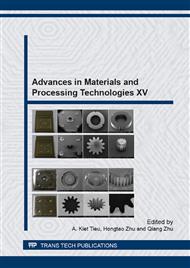p.818
p.827
p.833
p.842
p.851
p.865
p.880
p.887
p.894
A Study Wear Behaviour of Induction Hardened 4140 and Carburised 8617H Steels on 1040 Steel
Abstract:
This study was undertaken to evaluate the likely effect on the wear rate of changing the pinion material in a rack and pinion steering box from carburised SAE-AISI grade 8617 H steel to induction hardened SAE-AISI grade 4140 steel of the same hardness. Accordingly, pin on disc wear tests were conducted using carburised 8617 H pins and through hardened 4140 pins. The surface hardness of the pins was approximately 60 HRC for both materials. The discs were made of SAE-AISI grade 1040 steel through hardened to a hardness of 45 HRC. The results showed that both the pins and the discs wore more rapidly when the tests were carried out with 4140 pins. The study indicates that the wear rate would be increased on both the rack and the pinion if the pinion material were changed from case hardened 8617 H to induction hardened 4140.
Info:
Periodical:
Pages:
851-864
Citation:
Online since:
November 2013
Authors:
Keywords:
Price:
Сopyright:
© 2014 Trans Tech Publications Ltd. All Rights Reserved
Share:
Citation:


